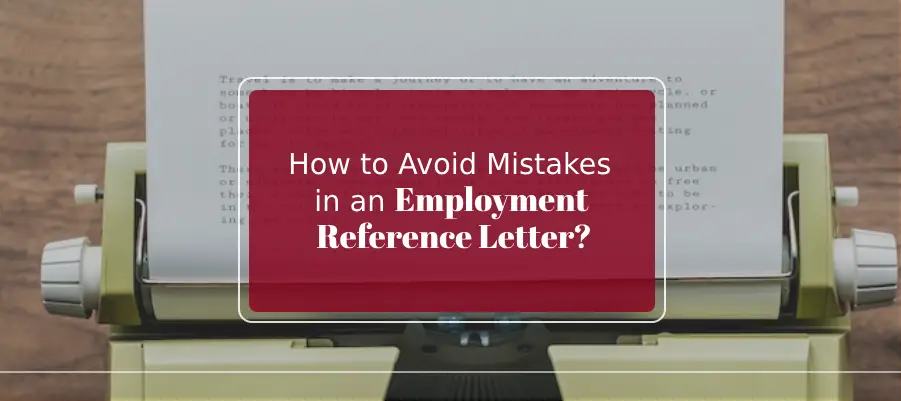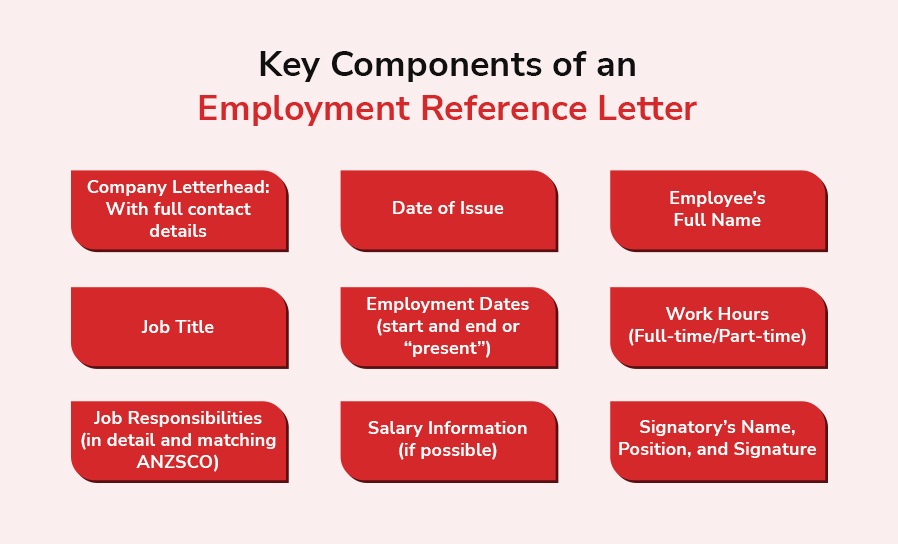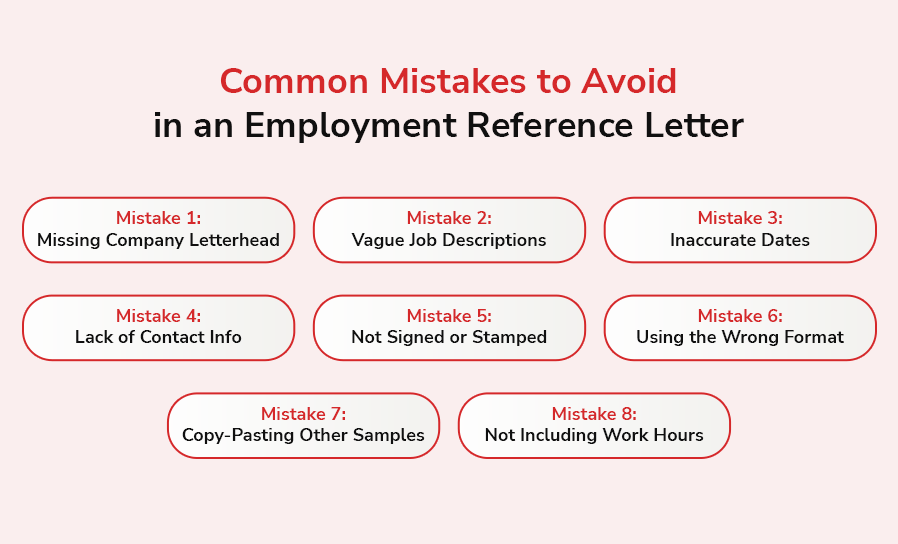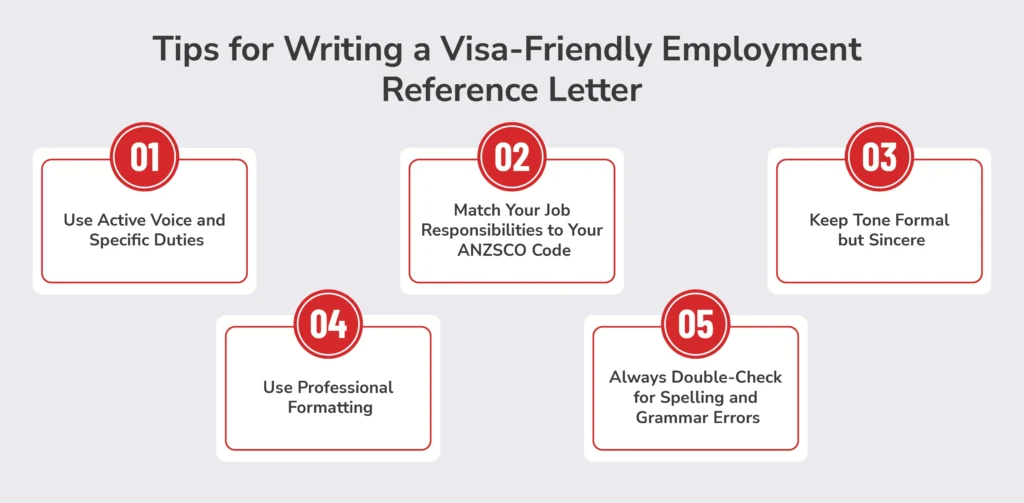
How to Avoid Mistakes in an Employment Reference Letter?
An employment reference letter is one of the most important documents when applying for an Australian visa, whether for skilled migration, general employment, or even a tourist visa supported by your employer.
Mistakes in this letter can lead to significant consequences such as delays, rejections, or even a failed skills assessment. This underscores the importance of understanding how to write a proper employment reference letter for visa purposes.
Let’s dive into everything you need to know to ensure your employment reference letter for Australian immigration is accurate, compliant, and compelling.
What Is an Employment Reference Letter?
An employment reference letter is a formal letter written by a current or former employer, verifying your job title, roles, responsibilities, skills, and length of employment, which serves as a work reference for a visa.
This letter confirms that you have worked in a relevant occupation for Australian immigration purposes, particularly if you are applying for a skills assessment or visa.
Why Is It Important for Australian Immigration?
The employment reference letter for Australian immigration plays a pivotal role in the following visa processes:
- General Skilled Migration (189, 190, 491)
- Employer-Sponsored Visas (482, 186)
- Temporary Graduate Visa (485)
- Tourist Visa with employer support
- ACS or VETASSESS Skill Assessment
Immigration authorities and assessment bodies, such as VETASSESS or Engineers Australia, use this letter to verify your claims about work experience, which contributes to your eligibility and points score for the Australian PR visa.
Who Should Write Your Employment Reference Letter?
The ideal person to write your employment reference letter for a visa is:
- Your direct supervisor or manager
- Human Resources personnel
- Company director or CEO (in smaller businesses)
The signatory must be someone of authority who can validate your work. This adds credibility to your employment reference letter.
Key Components of an Employment Reference Letter

An effective employment letter for an Australian visa application should include the following:
a. Company Letterhead: With full contact details
This is non-negotiable for official verification purposes.
Why it matters:
It confirms the letter’s authenticity and connects the document to a legally operating entity. For instance, Australian immigration officers or assessing authorities, such as VETASSESS or ACS, often cross-verify details directly with employers.
What to include:
- Company logo
- Company name (as registered)
- Physical address (head office or branch)
- Contact phone number
- Email address
- Company website (if applicable)
- ABN or ACN (for Australian employers)
✅ Tip: Ensure the letterhead is consistent with other documents, such as pay slips or offer letters.
b. Date of Issue
This is the date when the letter was officially written or printed.
Why it matters:
Immigration departments want recent documentation. A reference letter that is older than 12 months may be considered outdated, especially if it is used for a current application.
✅ Tip: Always issue the letter close to the date of your visa or skills assessment application.
c. Employee’s Full Name
Your complete legal name must be mentioned exactly as it appears in your passport.
Why it matters:
This avoids confusion or mismatches between official documents (like passports, employment letters, and payslips). Incorrect spelling or use of nicknames can delay verification or even trigger suspicion.
✅ Tip: Double-check for any spelling errors or name mismatches.
d. Job Title
The position you held during the employment period.
Why it matters:
Your job title must correspond to the occupation you’re claiming under ANZSCO. The assessing body (like ACS or Engineers Australia) uses this to determine if your experience is valid and relevant.
Example:
- “Software Engineer” (ANZSCO: 261313)
- “Civil Engineer” (ANZSCO: 233211)
✅ Tip: If your official title was generic (e.g., “Associate”), include a clear breakdown of your technical duties under the responsibilities section.
e. Employment Dates (start and end or “present”)
Mention:
- Start date (DD/MM/YYYY)
- End date (if applicable)
- Mention “to date” or “currently employed” if still working there
Why it matters:
Immigration authorities need to calculate years of experience for points allocation. Incorrect dates may lead to partial or full rejection of your claimed expertise.
✅ Tip: Match these dates with your tax records, payslips, or official HR documentation for accuracy.
f. Work Hours (Full-time/Part-time)
State the number of hours worked per week:
- Full-time = 38 hours or more
- Part-time = Less than 38 hours
Why it matters:
Only full-time employment (at least 20 hours per week) is generally considered for skills assessment and visa eligibility. Casual jobs or internships often don’t qualify unless detailed.
Example Statement:
“Mr. Rajesh Kumar was employed full-time, working 40 hours per week.”
✅ Tip: Avoid vague terms like “regular hours” or “standard time.”
g. Job Responsibilities (in detail and matching ANZSCO)
This is one of the most critical sections of the employment reference letter.
Why it matters:
Your described responsibilities must closely match the duties listed under your nominated ANZSCO code. This demonstrates that your work experience is directly relevant to the occupation for which you are applying.
How to do it right:
- Use bullet points
- Be specific: mention tools, systems, and types of projects
- Avoid copy-pasting from the internet
- Refer to the ANZSCO database for keywords
Example for a Data Analyst:
- “Analysed large datasets using SQL and Power BI to identify key business trends”
- “Developed and maintained dashboards to support executive-level decision-making.”
✅ Tip: Avoid generic descriptions like “handled data” or “managed reports.” Be technical and results-focused.
h. Salary Information (if possible)
This is optional but beneficial.
Why it matters:
Salary demonstrates the nature and level of the role. Higher salaries often imply a higher level of responsibility or seniority, which can support the relevance of your experience.
How to include:
- Annual or monthly salary (in local currency)
- Mention if gross or net
- Optional: add benefits (bonus, housing allowance)
✅ Tip: If including, ensure the salary matches payslips or tax records.
i. Signatory’s Name, Position, and Signature
This is your referee’s identification, which can be used person verify the information.
Why it matters:
Their credentials provide weight to the verification. Immigration or assessing bodies may contact them to validate the letter.
Include the following:
- Full name of the signatory
- Official position or title (e.g., “HR Manager,” “CTO”)
- Contact number and email
- Wet or digital signature (if sent electronically)
Bonus:
- Company stamp (if available)
- On official letterhead (again, critical)
✅ Tip: Always inform the referee in advance, so they are prepared in case someone contacts them.
These elements make your reference letter from your employer for a visa application professional and credible.
Employment Reference Letter Template for Visa
Here is a commonly accepted employment reference letter template for Australia:
[Company Letterhead]
Date: [DD/MM/YYYY]
To Whom It May Concern,
This is to certify that [Employee Full Name] was employed with [Company Name] from [Start Date] to [End Date / Present] as a [Job Title].
During their tenure, [he/she/they] was a full-time employee working approximately [Number] hours per week. Their primary roles and responsibilities included, but were not limited to:
- [Responsibility 1]
- [Responsibility 2]
- [Responsibility 3]
[Employee Full Name] has demonstrated a high level of competence, professionalism, and skill in fulfilling their duties.
If you require further information, please do not hesitate to contact me at [Phone/Email].
Sincerely,
[Name of Supervisor]
[Job Title]
[Signature]
[Contact Information]
Employment Reference Letter for VETASSESS
VETASSESS is one of the largest skill assessment authorities in Australia. If your occupation falls under the general professions category, you need to submit a VETASSESS employment reference letter.
VETASSESS-Specific Requirements
- Detailed roles and duties aligned with ANZSCO codes
- Full-time/Part-time hours
- Salary, if possible
- Supervisory signature with designation
- Multiple letters for multiple positions/roles
👉 Downloadable: employment reference letter for Australia. PDF versions are often submitted online to VETASSESS via their portal.
Employment Reference Letter for Engineers Australia
If you’re applying through Engineers Australia, you must prepare a reference letter that aligns with engineering competencies and includes:
- Clear indication of engineering-related tasks
- Tools, software, and equipment used
- Technical reports and design works handled
A weak letter can result in your Engineers Australia skill assessment being unsuccessful.
Common Mistakes to Avoid in an Employment Reference Letter

When preparing an employment reference letter for visa applications, even a minor mistake can have serious consequences, including delays, additional verification, skill assessment rejections, or even visa refusals.
Let’s dive into each common mistake and see precisely how you can avoid them.
❌ Mistake 1: Missing Company Letterhead
What Happens:
Suppose your employment reference letter is not printed on your company’s official letterhead. In that case, it may appear suspicious to immigration officers or skill assessment bodies, such as Engineers Australia, ACS, or VETASSESS.
A plain, unbranded paper doesn’t authenticate your employment claims.
How to Fix It:
Always ensure that your reference letter is on official company letterhead that includes:
- Company logo
- Registered name
- Physical address
- Official email and contact number
- ABN/ACN (for Australian companies)
✅ Pro Tip: The design of the letterhead should match your company’s official communications, such as offer letters or payslips.
❌ Mistake 2: Vague Job Descriptions
What Happens:
Writing generic or overly broad job responsibilities (e.g., “handled engineering tasks” or “worked on software projects”) is a big red flag. Assessing authorities match your job duties to specific ANZSCO occupation descriptions. If your letter is vague, your experience may not even be considered.
How to Fix It:
- Read your nominated ANZSCO code carefully.
- List specific responsibilities that directly align with the ANZSCO tasks.
- Use technical language relevant to your profession.
- Mention tools, platforms, software, or technologies you worked with.
Example for a Data Analyst:
✅ Good: “Developed interactive dashboards using Tableau to visualise sales performance metrics for executive-level decision-making.”
❌ Bad: “Worked on reports.”
✅ Pro Tip: Tailor the duties for every job if you are claiming points for multiple roles.
❌ Mistake 3: Inaccurate Dates
What Happens:
Incorrect joining or leaving dates or missing dates altogether can cause authorities to doubt your experience. Even a one-month mismatch with your payslips, tax records, or contracts can cause major verification issues.
How to Fix It:
- Confirm your exact joining date and resignation/end date.
- Mention if the employment is “currently ongoing.”
- Cross-verify with your HR records, payslips, and tax returns.
Format Example:
“From 15th March 2018 to 30th June 2022.”
✅ Pro Tip: Avoid using ambiguous terms like “Spring 2018” or “Mid-2022”; instead, use specific dates only.
❌ Mistake 4: Lack of Contact Info
What Happens:
Suppose your letter doesn’t mention your referee’s full name, position, and contact details. In that case, the verification team may find it challenging to confirm your employment, which could make them doubt the authenticity of the letter.
How to Fix It:
Every employment reference letter should include:
- Full name of the referee
- Their designation (like “HR Manager” or “Director of Engineering”)
- Official phone number
- Official company email address
✅ Pro Tip: Ensure that the email address domain matches the company website (e.g., HR@CompanyName.com).
❌ Mistake 5: Not Signed or Stamped
What Happens:
Unsigned or unstamped letters lack credibility. A missing signature or stamp can make your reference letter look like something you wrote yourself, rather than an official company document.
How to Fix It:
- Always ask your employer to sign the letter, either digitally or manually.
- Request a company stamp if available, especially for companies where this is the standard practice.
✅ Pro Tip: If sending digitally, ask for a scanned, signed version.
❌ Mistake 6: Using the Wrong Format
What Happens:
Poor formatting, such as casual language, missing sections, incorrect sequence, or unprofessional presentation, gives the impression that the letter is not official. Immigration officers expect a clear, formal business format.
How to Fix It:
Follow a structured employment reference letter template for visa applications:
- Company Letterhead
- Date
- Employee’s Full Name
- Employment Dates
- Work Hours
- Job Title
- Detailed Responsibilities
- Salary Information (optional)
- Referee Details
- Signature and Stamp
✅ Pro Tip: Maintain a formal and professional tone throughout the letter.
❌ Mistake 7: Copy-Pasting Other Samples
What Happens:
Plagiarising someone else’s employment letter, even if it’s a “sample employment reference letter for Australia” you found online, can backfire. Authorities may run checks and identify copied content, which can result in rejection or accusations of document fraud.
How to Fix It:
- Write your employment letter based on your real job duties.
- Refer to templates only for structure and style.
- Avoid using another person’s company name, job role, or responsibilities without modifications.
✅ Pro Tip: Always keep the content personalised and specific to your employment.
❌ Mistake 8: Not Including Work Hours
What Happens:
Omitting whether your job was full-time or part-time creates ambiguity. Immigration policies typically require full-time work (at least 20 hours per week) to meet eligibility criteria.
How to Fix It:
- State work hours, for example: “This was a full-time role, and Mr. Smith worked 40 hours per week.”
- If you are part-time, please specify the exact number of hours.
✅ Pro Tip: Even part-time experience can sometimes be considered (especially if it’s consistent over a long period), but clarity is key.
Sample Employment Reference Letter for Australia
Here is a sample employment reference letter for Australia used for skilled migration:
[Company Name]
[Address]
[Phone Number]
[Email Address]
[ABN if applicable]
Date: 10 March 2024
To Whom It May Concern,
This letter serves to verify that Ms. Priya Sharma was employed by Tech Solutions Pty Ltd as a Software Developer from June 1, 2018, to February 15, 2023, working full-time (38 hours per week).
Her key duties included:
- Designing, coding, and testing software applications
- Conducting system analysis and recommending improvements
- Collaborating with cross-functional teams for deployment
- Preparing documentation and user manuals
Priya consistently displayed strong technical and analytical skills. Her contributions significantly improved project timelines and product quality.
For verification purposes, please do not hesitate to contact me.
Regards,
David Liu
Senior Manager – HR
david.liu@techsolutions.com.au
(02) 8000 1234
Proof of Employment Letter vs. Reference Letter
What is a proof of employment letter?
A proof of employment letter simply confirms that an individual is employed. It includes:
- Name of employee
- Job title
- Employment dates
- Contact info of the employer
However, for visa or skill assessment purposes, a detailed employment reference letter is required that includes job roles and responsibilities.
Tips for Writing a Visa-Friendly Employment Reference Letter

Writing a visa-friendly employment reference letter is not just about explaining your past roles, but it’s about presenting your experience in a clear, formal, immigration-compliant way. Here’s a detailed look at how you can make your letter strong, genuine, and ready for any visa or skill assessment application:
1. Use Active Voice and Specific Duties
What It Means:
Use an active voice (where the subject acts) instead of a passive voice (where the subject receives the action).
Also, be very specific when describing what you did and don’t stay vague or general.
✅ Good Example (Active & Specific):
“I developed predictive models to optimise supply chain logistics using Python and SQL.”
❌ Bad Example (Passive & Vague):
“Predictive models were developed for supply chain purposes.”
Why It Matters:
- Active voice sounds more confident, direct, and credible.
- Specific duties help match your experience clearly to the occupation standards (especially ANZSCO descriptions).
- Immigration officers can easily verify and assess your claimed skills without having to guess.
🧠 Tip: Begin your bullet points or sentences with strong action verbs like ‘developed,’ ‘designed,’ ‘implemented,’ ‘ analyzed,’ ‘managed,’ ‘supervised,’ ‘coordinated,’ etc.
2. Match Your Job Responsibilities to Your ANZSCO Code
What It Means:
ANZSCO (Australian and New Zealand Standard Classification of Occupations) codes list specific job descriptions and tasks for each skilled occupation.
Your employment reference letter duties must align with the ANZSCO description for your nominated occupation.
✅ Example:
If you’re applying as a “Software Engineer” (ANZSCO 261313), you should include duties like:
- Designing and developing software systems
- Testing and debugging code
- Collaborating with other developers
❌ Mistake:
If you list duties that match a different occupation (like IT support or database administration), you could face rejection because your letter won’t prove you worked as a “Software Engineer.”
Why It Matters:
- Authorities such as Engineers Australia, ACS, or VETASSESS verify whether your actual job aligns with your nominated role.
- Poor alignment = wasted time and money.
🧠 Tip: Always read your ANZSCO unit group description carefully before writing the letter!
3. Keep Tone Formal but Sincere
What It Means:
Your letter should convey a professional, respectful, genuine tone, avoiding a robotic, overly casual, or exaggerated style.
✅ Good Tone Example:
“During her tenure, Ms. Khan demonstrated exceptional analytical capabilities, consistently delivering actionable insights to drive business decisions.”
❌ Bad Tone Example:
“She was a super amazing team member, always doing awesome work!”
Why It Matters:
- Immigration officers expect a formal tone that reflects standard business communication.
- Overly emotional, slang-filled, or fake-sounding language damages credibility.
- Sincerity builds trust. You want your letter to “feel real” to the person assessing it.
🧠 Tip: Avoid using buzzwords like “rockstar,” “ninja,” and “amazing”; instead, stay formal, calm, and honest.
4. Always Double-Check for Spelling and Grammar Errors
What It Means:
Proofread your letter very carefully for:
- Typos
- Incorrect punctuation
- Grammar mistakes
- Wrong dates or numbers
✅ Correct:
“The employee consistently met project deadlines and exceeded performance expectations.”
❌ Incorrect:
“The employee consistently meets project deadlines and exceeds performance expectations.”
Why It Matters:
- A letter full of errors looks unprofessional and careless.
- Immigration authorities might question the authenticity or professionalism of your company.
- Minor mistakes can cause major misunderstandings.
🧠 Tip: Always use tools like Grammarly or ask a colleague or professional to proofread your letter before submitting it.
5. Use Professional Formatting
What It Means:
Present your letter in a well-structured and polished format that adheres to the standard expectations of business communication.
✅ Professional Formatting Includes:
- Printed on official company letterhead
- Proper margins and spacing
- Standard professional fonts like Arial, Calibri, or Times New Roman (size 11-12)
- Clear headings (e.g., “To Whom It May Concern”)
- Logical flow (Introduction → Employment Details → Job Duties → Closing Remarks)
- Signed by an authorised company representative
- Company stamp (if available)
Why It Matters:
- Clean formatting makes your letter easier to read and more credible.
- Immigration officers appreciate documents that are organised and easy to verify.
- A good presentation shows respect for the seriousness of the visa process.
🧠 Tip: Stick to simple black text on a white background and no fancy colours, patterns, or images.
How to Ask for a Reference or Employment Letter
Here’s how you can politely ask for a reference letter:
Email Sample:
Subject: Request for Employment Reference Letter
Dear [Manager’s Name],
I hope you’re well. I am applying for a skilled migration visa to Australia or a tourist visa and need an employment reference letter that outlines my duties, tenure, and job title.
I can provide a template and draft for your review to make it easier.
Thank you in advance for your support.
Warm regards,
[Your Full Name]
Conclusion
Writing an effective employment reference letter for Australian immigration can be the difference between a successful and rejected visa application. Avoiding common mistakes, such as vague duties, missing information, and improper formatting, is crucial. Use the employment reference letter template we provided for Australia, and ensure each letter is tailored to your occupation and visa requirements.
Whether you’re applying for a skilled visa, tourist visa, or a VETASSESS or Engineers Australia skill assessment, the correct letter sets the foundation for your journey.
Need help drafting the perfect letter? Contact professional visa documentation services that thoroughly understand Australian immigration requirements. It’s always better to be accurate than risk rejection due to a simple letter mistake.
Frequently Asked Questions
1. What should an employment letter include?
- Company letterhead
- Dates of employment
- Job duties
- Work hours
- Contact information
- Signature
2. What do you write in an employment reference letter?
You should include specific job duties, start and end dates, job title, work schedule, and an endorsement of the employee’s performance.
3. Can I submit a scanned copy?
Yes. For Australian immigration, scanned employment reference letters in PDF format are commonly accepted.
4. Do I need a separate letter for each job?
Yes. Each job role at a different company or in a different position requires a separate letter.
5. How to Write a Reference Letter to an Employer?
Typically, the applicant drafts the letter and sends it to the employer for review and printing on official letterhead.
